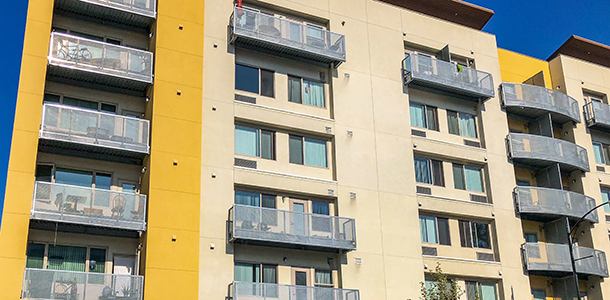
(Photo: Will Buckner/Flickr)
Editor’s Note: This story is Part 1 of Unlocking Infill, a California Economic Summit series on the complexities of infill development. If you have ideas for topics that should be covered in this series, we want to hear them. Send your idea to info@cafwd.org.
California is increasingly focused on promoting infill development to meet greenhouse gas targets and satisfy consumer demand for walkability and short commutes. Gov. Newsom’s budget adds to that focus with a $500 million deposit into a competitively awarded grant program for infill infrastructure.
No single definition of infill exists in California. But many state laws and guidelines – including SB 375 and CEQA – share an underlying presumption that infill occurs in places that are fundamentally “urban.” For example, places that are dense, surrounded on several sides by existing development, and are a short walk from high-frequency transit that runs at least every 15 minutes or less.
Taken together, these criteria effectively point infill to the most urban of the state’s communities. But what kinds of communities are left behind when infill policies are overwhelmingly focused on urban settings? What happens in small towns or rural communities without high-frequency transit, or in suburban areas that are embracing density but don’t yet have a transit system to match bigger cities? Does that mean the state should not encourage “infill” housing there that’s walkable to nearby amenities?
To help gain perspective on this question, California Forward spoke with Davis-based infill developer Meea Kang for the first installment of Unlocking Infill, an occasional series on the complexities of California infill development. Trained as an architect, Kang cut her teeth as an affordable housing developer in San Francisco and has developed more than 2,000 affordable units throughout the state.
California Forward (CF): Why does it matter how the state defines “infill?”
Meea Kang (MK): The definitions matter because they unlock streamlined development processes or access to funding.
CF: Are there places where the state’s typical infill definitions work well?
 MK: Yes, lots of places. If you’re talking about a place like Oakland, or any other urban core, it’s great. Land there is usually already zoned for the kinds of density they’re talking about. The political leadership is on board. They have the kind of transit you need. The problem is that so many places in California are not dense downtowns. To me, what these guidelines are saying is that it’s not as important to try to put infill in other settings.
MK: Yes, lots of places. If you’re talking about a place like Oakland, or any other urban core, it’s great. Land there is usually already zoned for the kinds of density they’re talking about. The political leadership is on board. They have the kind of transit you need. The problem is that so many places in California are not dense downtowns. To me, what these guidelines are saying is that it’s not as important to try to put infill in other settings.
CF: Can you give an example of places where infill ought to be incentivized but isn’t?
MK: Sure. Think about a rural town that has an historic main street. Maybe they have restaurants and some businesses and they are trying to attract workers who can afford to live there, and younger people – that’s a real problem for many rural places. Let’s say they want to put apartments over storefronts, or build town houses. In a place like that, you are never going to get to the densities many of these infill guidelines require, because the market won’t support it. And you’re definitely not going to have the kind of transit required because there just isn’t the demand. But does that mean places like those should not be encouraged to become more dense in a way that’s appropriate for their circumstances?
Let’s take it out of the rural setting and consider a suburban scenario – many of those places face a similar problem. If they’re not able to accommodate the kinds of density and transit prescribed, they fall into a kind of no-man’s land: yes, a developer can try to build it if he or she can win the entitlements, overcome local objections, get the funding together and deem it worthwhile to try to develop. But the definitions of infill we have now are not helping. Throughout the state, we have many wonderful, skipped-over parcels that could be developed into housing. With more support for infrastructure and more flexibility on definitions of infrastructure we could start to see more of them developed.
CF: To be clear, though, there is nothing about state guidelines that prevents such a town or a suburb from building infill now, right? Why does the state need to specifically encourage those kinds of infill?
MK: The reality is that housing is so expensive to build, everywhere. Any time the state can help ease the glide path by making processes shorter through streamlining rules, or offer ways defray development costs, that means the housing is more likely to get built. Sure, the hypothetical Main Street developer or suburban developer can go for it and try to build infill. But they will have an easier time with incentives. The issue is the state’s incentives do not reach enough places where infill can be encouraged.
CF: Do you have any prescriptions for change? If you could wave a wand, what would you have done differently?
MK: The way the system works now overwhelmingly favors urban infill, even though urban infill is getting more and more expensive to build. I am not saying don’t build urban infill – I have built lots of urban infill and I think it’s really needed. I am just saying let’s try to level the playing field among all types of infill. We need guidelines that encourage a wider range of infill. Guidelines that say, ‘Look, as long as you are inside these areas that already have services like sewers and water and roads, as long as you have access to jobs, and as long as you’re not building on farmland, we’ll help you.’”
CF: It sounds like one of the issues in current infill definitions has to do with it being linked to high-frequency transit. One the one hand, you need population density to make high-frequency transit work. But developers can’t get state help building greater densities until the transit is already there.
MK. Absolutely. I have mapped transit throughout California and here is what I have found: It’s everywhere. It might not be “high-frequency,” or “high-quality,” but it’s a start and it’s something to build upon. We have set up criteria for infill based on standards with unintended consequences. Yes, we can all believe in public transit, but we will move in different ways and we’ll have more biking and pedestrians and scooters and maybe more Ubers. That is what the definition needs to capture. So now it’s a moment to refresh. To hit pause and say, ‘Does this definition still meet with where the opportunity is? Do our policies reduce greenhouse gases, increase multi-model transportation, get more affordable housing where it needs to be, and build infrastructure?’ The reality is no, not yet. That’s where we need to go with modernized infill guidelines. We need to line these things up together.

